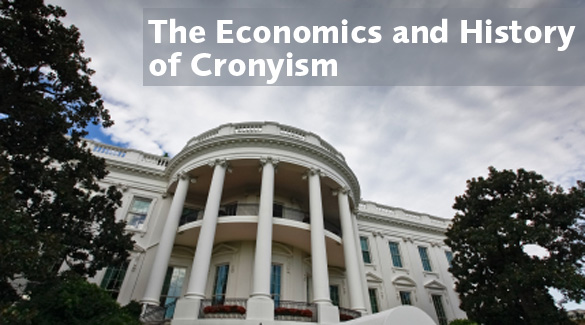
David R. Henderson
“When you leave the honey jar open, expect ants.”
—anonymous
—anonymous
When
I speak of the benefits of economic freedom and free markets, many
people in my audiences do not think of those terms the way I think of
them. In the question-and-answer sessions that follow my talks, it seems
people often think they are taking issue with free markets when they
are actually rejecting cronyism—a term that encompasses government
favoritism, special privileges, and special interests.
For
example, people will object to the Wall Street bailouts carried out by
the Bush and Obama administrations. As do I, because those bailouts
violate free-market principles. They will object to government
regulation that makes it difficult for small food producers to produce
and sell food not inspected and approved by the U.S. Department of
Agriculture. As do I.
As we shall see, cronyism has
been around for a long time and is a bipartisan problem that has thrived
under Democratic and Republican presidents and congresses. Cronyism not
only picks winners based on political connections rather than on the
extent to which they serve consumers, but also is destructive of wealth,
sometimes highly so.
This is not a comprehensive
overview of cronyism. No short study could be. Rather, it provides a
perspective of cronyism: what it is, what’s wrong with it, some examples
of it, why it happens, and how to reduce it.
WHAT IS CRONYISM?
What
is the difference between free markets and cronyism? In free markets,
buyers and sellers are free to agree on price; no government agency
restricts who can buy or sell, and no one is told how or what to
produce.[1] In contrast, under cronyism the government rigs the market
for the benefit of government officials’ cronies. This takes various
forms. Governments sometimes grant monopolies to one firm or limit the
number of firms that can compete. For example, most U.S. municipalities
allow only one cable company to operate in their area even though there
is no technological reason more could not exist. The same is true for
most other utilities.
Governments sometimes use quotas
or tariffs to limit imports with the goal of protecting the wealth and
jobs of domestic producers who compete with those imports. President
George W. Bush did this in 2002, for example, when he imposed tariffs
ranging from 8 to 30 percent on some types of imported steel.[2]
Governments sometimes subsidize favored producers, as the Obama
administration did with the politically connected solar-energy firm
Solyndra. Governments may use antitrust laws to prevent companies from
cutting prices so that other, less-efficient companies can prosper: For
example, beginning in 1958, the U.S. government prevented Safeway from
cutting prices for a quarter of a century.[3]
The
entities governments help with special regulations or subsidies are not
always businesses; sometimes they are unions. The federal government’s
National Labor Relations Board’s (NLRB) complained against Boeing in
April 2011, for example. In response to a complaint from the
International Association of Machinists and Aerospace Workers (IAM), the
NLRB sought to require Boeing to produce its 787 Dreamliner in
Washington State rather than in Boeing’s chosen location of South
Carolina. According to the NLRB, by saying that “it would remove or had
removed work from the [Puget Sound and Portland] Unit because employees
had struck” and by threatening that “the Unit would lose additional work
in the event of future strikes,”[4] Boeing was making “coercive”
statements to its employees. As a matter of fact, it was not. Boeing was
simply telling the employees some likely consequences of the union’s
actions.
The Boeing-IAM case is not as simple as most
of the press implied. It turns out there was a prior case of cronyism.
The government of South Carolina promised Boeing “$900 million in tax
relief and other incentives” in exchange for moving production to South
Carolina.[5] Such is the tangled world of cronyism.
Continue Reading
No comments:
Post a Comment